Menu
ESI Stories
Following the Rhythm of Leticia
Azania, a master’s student in the MIT Department of Architecture, reflects on her field experience in the ESI-created course Biodiversity and Cities: A Perspective in Colombian Cities.
March 24, 2023
by Azania
In August 2021, the Ministry of Environment and Sustainable Development of Colombia selected Leticia, known as “El Corazón del Amazonas” (“The Heart of the Amazon”), as one of fourteen cities for its BiodiverCities Initiative, representing a national effort to support the creation of nature-positive urban development throughout the country.
However, though many appreciate the importance of this goal, how to achieve it remains challenging to uncover. For do we, as inheritors of the neoliberal city, have the capacity to articulate, or more importantly, even imagine what a biodiverse city could look like? Perhaps it is a place in which the built and natural environments coexist seamlessly? Or, is it one in which the threshold between the city and nature is defined–structurally, visually, or intangibly? And most importantly, how do we center equity in the process, creation, and proliferation of a BiodiverCity? These are some of the questions that the city of Leticia is grappling with and the MIT Environmental Solutions Initiative (ESI) and the Department of Urban Studies and Planning (DUSP) are tackling through the spring practicum Biodiversity and Cities: A Perspective in Colombian Cities.
“At the MIT ESI, we have a long-term commitment with Colombia and see the work of the students in the class as a starting point to identify potential research collaboration opportunities that could be further developed and carried out through the Natural Climate Solutions Program at ESI. We are interested in continuing partnering with the local institutions, and helping mobilize the resources needed for the implementation of projects that might come out of this academic exercise.”
– Marcela Angel, Research Program Director at ESI
In January 2023, a cohort of three researchers and twelve MIT students met in Bogotá, Colombia, to embark on a week-long field visit to Leticia with one primary goal: to begin to understand and document the inherent complexities of the city. Because although Leticia is a small town of just over 40,000 people, it holds a complex memory. Dating back to the 18th century, the city has been at the center of territorial conflicts with Peru, with which Colombia currently shares a river border, and with Brazil, with which Colombia currently shares a land border. Leticia is the manifestation of geopolitical extensions of control, which continue to shape how we understand and conceptualize the “Amazon” and will thus shape the effectiveness of any biodiversity conservation in the city.
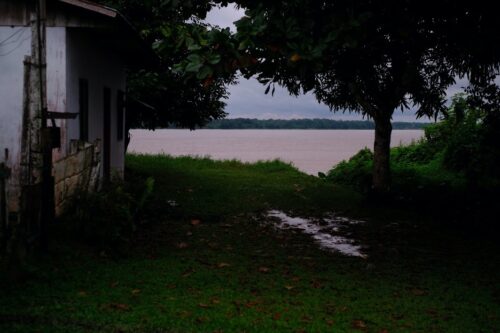
View of Peru across the Amazon River from Tabatinga. Photo: Azania
“The challenges of urbanization in the Amazon are not new–they are rooted in multiple cycles of colonization of the region, including most recently the infamous rubber boom that placed indigenous groups in practically forced labor. Recognizing this history is necessary to chart a sustainable path forward.”
– Marco Herndorn, MCP Candidate
The fieldwork consisted of a series of meetings and exchanges with on-the-ground partners, local change-makers, and government officials. Our group convened at SINCHI–El Instituto Amazónico de Investigaciones Científicas–early in the week to listen to the voices of several perspectives on biodiversity and development in Leticia. Mario López Castro, Coordinator of Urban Management at the Ministry of Environment, urged the team to “think of how to create harmonious ways of interacting with the environment.” Professor John Fernández highlighted the importance of investigating “harmony with biodiversity,” acknowledging that “cities are not conducive to greater biodiversity” and challenging us to view biodiversity as a portal to and through other socioeconomic issues. Juan Carlos Bernal of Colombia’s Regional Environmental Authority Corpoamazonia, articulated the disjointed manner with which each stakeholder was approaching the topic and shared thoughts on the political difficulties of working with Tabatinga, Leticia’s sister border city in Brazil. Franz Silva of Red Jovenes de Ambiente spoke on behalf of the 12,000 young people in Leticia, agreeing that the disconnected efforts were a disservice and calling for unity of purpose and collective responsibility. And finally, William Yucuna, Maloquero* of the Capiul indigenous community, reminded the audience that the spiritual aspect of biodiversity holds weight, calling for a change in mindset and respect to the indigenous peoples as the original stewards of the land. These voices held elements of hope, frustration, drive, and reserve. As the afternoon continued and the magnitude of the morning’s statements began to set in, the team began concretizing notes on the importance of collaboration and proposals for co-production and stakeholder cooperation began to emerge.

Members of the MIT cohort with community meeting participant, Franz Silva, of Red Jóvenes de Ambiente. From left to right: Rizki Rayani, Linh Trinh, Franz Silva, Patricia Garcia and Lidia Cano. Photo: Azania
“I believe it is fundamental for the government, activists, academics and the communities to find a way to work together towards the conservation of biodiversity and the environment. It takes all of us to accomplish this task.”
– Patricia Garcia, MCP Candidate
Over the course of the week, the group also had the opportunity to take a closer look at the relationship between the indigenous communities living in the city and its surrounding areas, co-facilitated by Juan Felipe Guhl, Program Director of Socio-Environmental Dynamics at SINCHI. Many of the indigenous communities stand firm in their role as historic stewards and their relationship of taking away and giving back to the land, but acknowledge the pressures they are facing in carrying on this role: some identify a lack of education, flooding, and deforestation as significant threats.
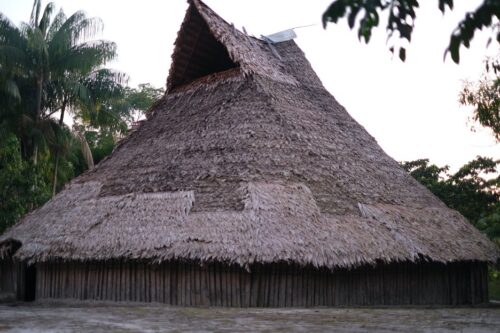
Maloca of Agustina in the peri-urban area of Leticia. Photo: Azania
La Isla de La Fantasia, a semi-autonomous agricultural community, represents a clear case of how the city’s development is confronted with historic stewardship and climatic and hydrological dynamics. Rubiela Pereira, President of the Community Board of Isla de la Fantasia, led our group through a visit around the island. Currently, the island experiences six months of a high water season and six months of a dry season. The flood season provides nutrients to the crops that are harvested in the dry season, and the settlement model is an example of traditional indigenous settlements built on stilts to co-exist with the water. Nevertheless, it also exacerbates rampant economic instability due to a short agricultural season and inadequate access to resources to safely navigate high waters. The residents also pointed out the saturation of the market across the creek that separates the island from Leticia, claiming it can be hard to sell products at a competitive price since there are so many vendors and relatively few consumers, further contributing to their financial hardships. Of the 1100 inhabitants of the island, the majority are experiencing extreme hardship due to underinvestment from the government and a lack of basic public services. Tensions rose when Fernanda Pérez, a representative from the mayor’s office, claimed it was difficult to justify municipal economic support for the island as it is in a flood risk zone and is considered neither a formal neighborhood nor an indigenous reserve. Residents were quick to point out that from their perspective, a lack of support from the government was due to “a lack of political will” and nothing more. As described by Erik Vergel, professor at Universidad de los Andes, these tensions are representative of a persistent contradiction between urban regulations and traditional settlement models in Amazonia, where the occupation of flood-prone areas for human settlements and agriculture have been traditional practices of indigenous communities but have not been appropriately incorporated into urban regulations and planning instruments due to the difficulty of mitigating risks in these areas. This has resulted in underinvestment in housing, infrastructure and lack of public services in these areas. The community of Isla de la Fantasia, whose members come from different indigenous communities in the region, is fighting to maintain residence on the land that they feel is rightfully theirs, in many ways to maintain their semi-rural indigenous practices and access to the city and to avoid a future similar to the indigenous of the Urban Maloca of Capiul, an urban Maloca that gathers indigenous peoples who have been displaced from their rural territories and are now living within the city of Leticia.
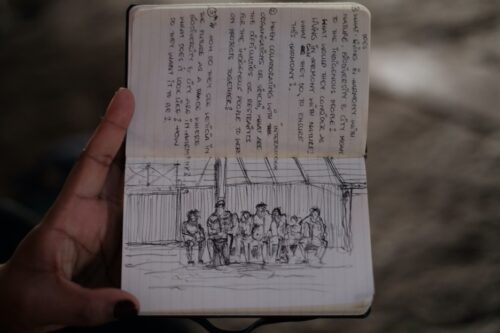
A sketch of the Urban Maloca of Capiul by Joris Komen, Architect, Doctoral Student in Computation at MIT. Photo: Azania
“To say we are not a community nor a neighborhood is the same as saying we don’t exist!”
– a member of La Isla de La Fantasia
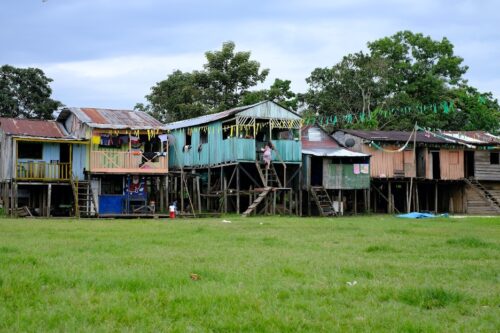
La Isla de La Fantasia. Photo: Azania
The residents of La Isla de La Fantasia are not the only group attempting to leverage agriculture and biodiversity as economic drivers. A women-lead cooperative is actively engaged in urban agriculture near the Urumutú wetland and helping create awareness to preserve the land from informal occupation, and SINCHI is leading numerous efforts to support the use of local bio-products into value-add products such as copoazú, camu camu and acai, among others. However, as shared by Juan Carlos Bernal of Corpoamazonia, there is also an illegal extractive market for biodiversity, which exports prized, rare captures and killings of the exotic species that reside within the forest.

MIT delegation and collaborators returning from La Isla de La Fantasia. Photo: Azania
The creation and implementation of a BiodiverCity is a call for radical change, referring not to the speed but to the scale of the change. Throughout our visit, the complexity of a national program being implemented at a local scale was evident, with multiple actors focusing their efforts alongside a rather narrow view of cooperation. However, Professor Gabriella Carolini warns against naïve calls for cooperation, explaining that cooperation on the ground can be messy and cloudy and requires the clear inclusion of equity in project goals to have a chance of being successful. She explains that the co-production of these project goals is crucial, paying particular attention to who has the capacity, namely the time and resources, to even participate in the co-production of the project objectives. It remains clear that the city of Leticia is the target for growing speculation, and now is the opportunity to think critically about a short and long-term trajectory that could truly transform the city’s relationship with its inhabitants and biodiversity amidst rapid urbanization. However, what might limit the successful growth of the city, including whether the idea of growth can be divorced from outdated, capitalist definitions surrounding an increase in GDP and instead truly center the human experience, is yet to be determined. Only time will tell how the story in Leticia will unfold; in the meantime, our team will attempt to make suggestions that do not disrupt the natural rhythm of the heart of the Amazon.
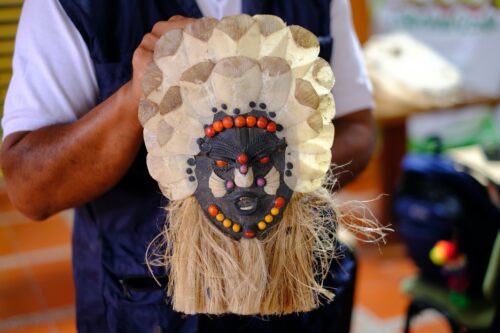
Juan Carlos shows an indigenous mask using the Pirarucú fish scales as adornment. Photo: Azania
This experience is part of an ongoing course entitled Biodiversity and Cities: A perspective in Colombian Cities, led by ESI + DUSP faculty and researchers: Professor John E. Fernández, Professor Gabriella Carolini, Marcela Angel, Norhan Bayomi, and Alessandra Fabbri.
* Maloquero is an indigenous title for the owner of the Maloca, a person who holds responsibilities in guiding the community.















